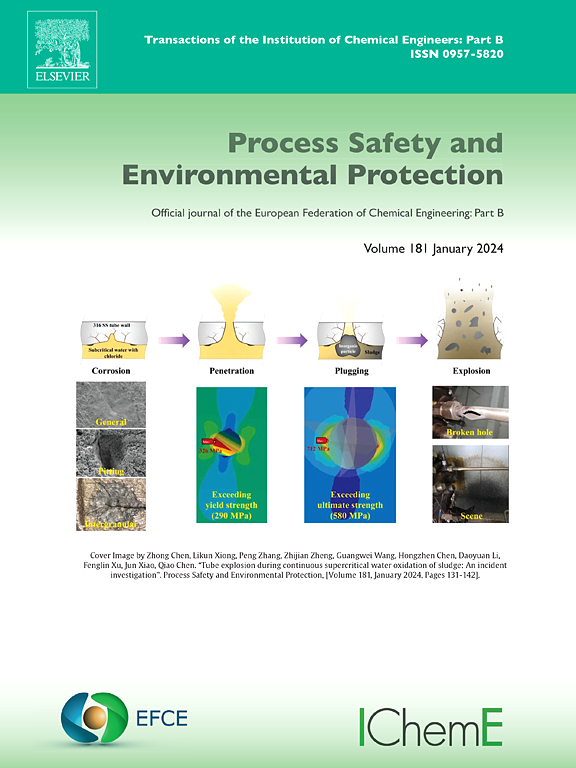利用氯化、紫外线和紫外线/H2O2有效消毒水中的抗生素耐药细菌和抗生素耐药基因
IF 7.8
2区 环境科学与生态学
Q1 ENGINEERING, CHEMICAL
引用次数: 0
摘要
安全和清洁的饮用水对于维持健康的社会和社会经济发展至关重要。不幸的是,大量抗生素释放到水体中导致环境中抗生素耐药细菌(ARB)和抗生素耐药基因(ARGs)的发展。因此,开发新的和改进的消毒方法,以提高处理后的废水的质量,以便回收或排放到水体中,这是一个越来越受关注的问题。研究了过氧化氢(H2O2)、氯化(Cl2)、254nm紫外光(UV-254)、UV-254/H2O2、369nm紫外光(UV-369)和UV-369/H2O2处理对大肠杆菌、肠炎沙门氏菌11RX、无性李斯特菌、铜绿假单胞菌和耐甲氧西林金黄色葡萄球菌的消毒效果。在多种样品基质中评估消毒效果,包括超纯水、废水流入和流出水。不同菌株的去除率依次为:UV-254/H2O2 >;uv - 254比;这有点难度比;uv - 369 /过氧化氢比;uv - 369比;过氧化氢。UV-254/H2O2、UV-254、Cl2、UV-369/H2O2和UV-369处理在0.5、1、2、20和30min时,大肠杆菌去除率分别达到4对数(99.99%),而H2O2单独处理30min后,大肠杆菌去除率仅为97.6%。UV-254和UV-254/H2O2也能去除抗生素耐药基因,速率常数为0.3445 ~ 0.6122min-1。本研究的结果表明,将H2O2与太阳光偶联是减少再生水中机会性人类病原体数量的一种有希望的替代方法。本文章由计算机程序翻译,如有差异,请以英文原文为准。
Effective disinfection of antibiotic resistant bacteria and antibiotic resistance genes from water using chlorination, UV and UV/H2O2
Safe, clean water is vital to maintain healthy societies and socioeconomic development, yet providing it remains an evolving challenge for water managers. Among the numerous contaminants that need to be managed, antibiotic resistant bacteria (ARB) and antibiotic resistance genes (ARGs) are recognized globally as a growing priority, and the development of new and improved disinfection methods to remove them and their drivers (e.g., antibiotics) from treated wastewater effluents for recycling or discharge to water bodies is a matter of increasing interest. This study investigated the disinfection efficacy of hydrogen peroxide (H2O2), chlorination (Cl2), ultraviolet light at 254 nm (UV-254), UV-254/H2O2, ultraviolet light at 369 nm (UV-369) and UV-369/H2O2 treatments against several bacterial strains (i.e., Escherichia coli, Salmonella enteritidis 11RX, Listeria innocua, Pseudomonas aeruginosa and methicillin-resistant Staphylococcus aureus). Disinfection efficacy was assessed in multiple sample matrices, including ultrapure water, wastewater influent, and effluent waters. Irrespective of the bacterial strain, the removal efficacy followed the order: UV-254/H2O2 > UV-254 > Cl2 > UV-369/H2O2 > UV-369 > H2O2. 4-log reduction (99.99 % removal) of E. coli was achieved at 0.5, 1, 2, 20 and 30 min by UV-254/H2O2, UV-254, Cl2, UV-369/H2O2 and UV-369 treatments, respectively, whereas H2O2 alone only achieved 97.6 % removal of E. coli after 30 min of treatment. UV-254 and UV-254/H2O2 were also able to remove antibiotic resistance genes with an observed rate constant ranging from 0.3445 to 0.6122 min–1. The findings of this study suggest that coupling H2O2 with solar light is a promising alternative approach for reducing the quantity of opportunistic human pathogens in reclaimed water.
求助全文
通过发布文献求助,成功后即可免费获取论文全文。
去求助
来源期刊

Process Safety and Environmental Protection
环境科学-工程:化工
CiteScore
11.40
自引率
15.40%
发文量
929
审稿时长
8.0 months
期刊介绍:
The Process Safety and Environmental Protection (PSEP) journal is a leading international publication that focuses on the publication of high-quality, original research papers in the field of engineering, specifically those related to the safety of industrial processes and environmental protection. The journal encourages submissions that present new developments in safety and environmental aspects, particularly those that show how research findings can be applied in process engineering design and practice.
PSEP is particularly interested in research that brings fresh perspectives to established engineering principles, identifies unsolved problems, or suggests directions for future research. The journal also values contributions that push the boundaries of traditional engineering and welcomes multidisciplinary papers.
PSEP's articles are abstracted and indexed by a range of databases and services, which helps to ensure that the journal's research is accessible and recognized in the academic and professional communities. These databases include ANTE, Chemical Abstracts, Chemical Hazards in Industry, Current Contents, Elsevier Engineering Information database, Pascal Francis, Web of Science, Scopus, Engineering Information Database EnCompass LIT (Elsevier), and INSPEC. This wide coverage facilitates the dissemination of the journal's content to a global audience interested in process safety and environmental engineering.
 求助内容:
求助内容: 应助结果提醒方式:
应助结果提醒方式:


